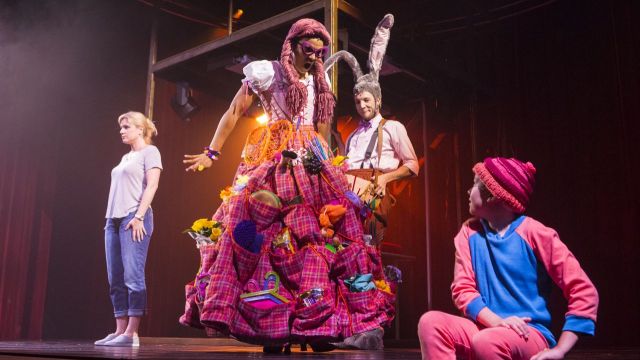Masquerade
In Kit Williams’ book Masquerade, the Moon, who has fallen in love with the Sun, sends her special messengers, Jack Hare and the frog, with a jeweled amulet and a riddle to tell him of her love. The Hare’s journey must be completed in a day, and is fraught with many obstacles. The story, interspersed with beautifully wrought illustrations, riddles and messages about life, and love, and loss, has been special to many children around the world.
It was more than special to playwright Kate Mulvany. As a child fighting a pervasive illness “Masquerade made the timelessness of a children’s oncology ward somehow bearable”. With Kit Williams himself as mentor and friend, she has interwoven her own story and the magic that is Masquerade into a beautiful and moving piece of theatre, which, like the book, has universal appeal.
The play begins as Tessa begins to read Masquerade to her son Joe who is suffering the pain, uncertainty and isolation of chemotherapy treatment. Thus Mulvany’s own story and Williams’ book are brought together. Tessa’s reading introduces the book and its characters to those who may not have read it – and the characters then come to vivid life on the stage of Joe’s imagination.
The creative team behind this production has faithfully recreated the colour and detail of Williams’ illustrations.
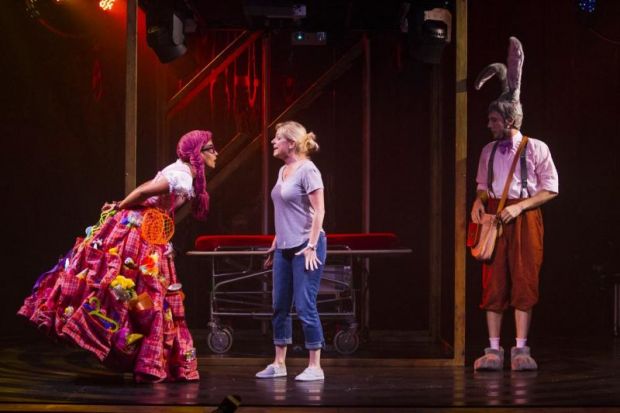
Designer Anna Cordingley has completely framed the stage with a haphazard alphabet interspersed with pictures of a hare, the moon and the sun. At various moments in the play, letters light up to help solve riddles. A copy of Masquerade shines luminescently on stage left. Central to the design is Joe’s hospital bed and its surrounding curtains, used to take the play from the reality of the hospital to the characters and landscapes of the book.
Intricate lighting effects (Geoff Cobham) and Audio Visuals (Chris Petridis) on multiple scrims take Jack Hare through the hazards of his journey. The musicians (Mikelangelo and The Black Sea Gentlemen) are cunningly placed on the stage, their presence as well as their music, composed by Mikelangelo and Pip Branson, enhancing the atmosphere and becoming intrinsic to the action.
Cordingley’s beautiful costumes bring Williams’ illustrations to three-dimensional life. She has lovingly contemporized and enhanced the costumes for each character, but lost none of their original charm and intricacy.
Directors Lee Lewis and Sam Strong have been just as empathetic to the play as Mulvany has been to the book. Their direction is light. There is a sense of evolution, a sense of warmth and togetherness. It is obvious that the whole ensemble has had fun recreating the characters, overlaid as they are with the moving reality of Joe’s illness.
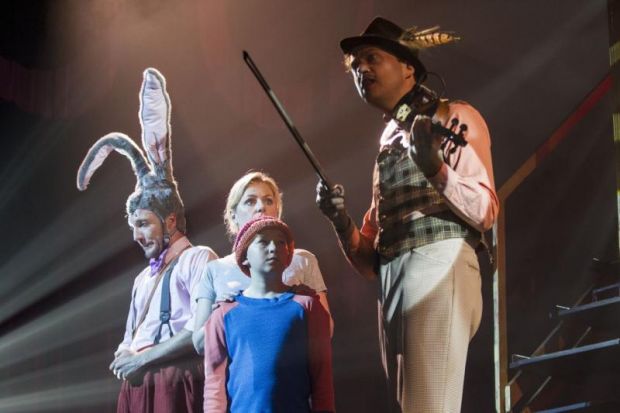
Helen Dallimore and Nathan O’Keefe take the first half of the play from reality to fiction with finesse. As Tessa, Dallimore combines the role of storyteller and agonised mother with the attention to detail that is typical of all of her work. She manages heartache and desperation beneath a mask of positivity she must maintain as her son suffers and hope fades. There is weariness and helplessness underlying the bright façade with which she faces each long day.
Nathan O’Keefe is energetically beguiling as Jack Hare. Light on his feet, appealing in his facial expressions, enthusiastic one moment, blighted the next, he brings the audience along on his journey, his timing making the most of every comic aside and moving moment.
Jack Andrew and Louis Fontaine share the role of Joe, and Mulvany’s dialogue has just the right vocabulary, sentence construction – and cheekiness – for a 10 year old. Jack Andrews played Joe on opening night, relating believably with Dallimore and finding moving poignancy at specific moments, especially in his heart-breaking song, I Dream of Outside, towards the end of the play.
Kate Cheel plays both the Moon and Tata Treetops. As the Moon she floats about the stage, her silver costume and curls shimmering. She is ‘mooningly’ love sick one minute, fiercely bossy the next. As Tara Treetops she sweeps onto the scene in a gust of wind, her skirts swirling, feathers from the crow on her shoulder fluttering about the stage. The characters are as contrasting as can be, and she carries both with flair.
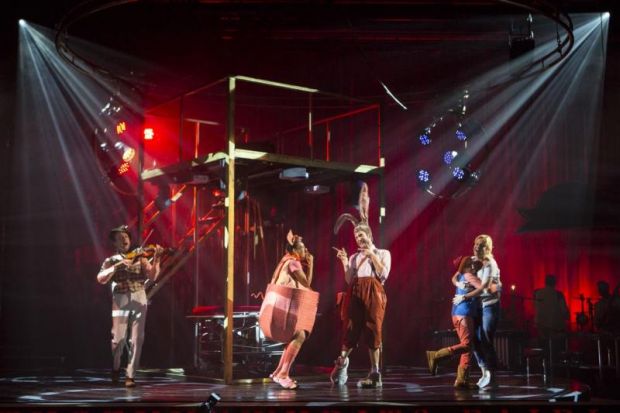
Zindzi Okenyo shows agility, timing and flexibility in five very different roles. As Penny Pockets she struts and pouts, cajoles and threatens, swinging her many- pocketed crinoline and all its intriguing contents airily around the stage. As the Fat Nurse she is efficient and almost chillingly distant; as the very pink, dancing Fat Pig, she is expressively amusing. As Fish, her controlled movement and gurgling voice are swimmingly (!) effective; and as Dawn, she stretches and coils with Yoga efficiency (my 3 year old grandson is a fan of Zindzi’s from her appearances on Play School and would have loved her in these very zany roles).
Musical directors and composers Mikelangelo and Pip Branson move on to the stage as actors as well as musicians. Mikelangelo plays The Sun and The Practical Man. As the Sun, playing a guitar and dressed in gold, he is a sad character (he thinks he’s ugly because people squint at him!). As The Practical Man he is devious and shifty.
Pip Branson as The Man Who Plays the Music That Makes the World Go Round (ie Time!), sets the rhythm of Jack Hare’s journey … and Joe’s illness. Branson also plays a lispy Sir Isaac Newton (complete with apple) and the voice of Craw the Crow.
This is an amazing production. It is everything I’d hoped it would be, based as it is on a book that has intrigued two generations of my family. Careful and loving writing, deft direction and talented design and acting have brought Kit Williams’ characters and what they have meant to many children … especially to a sick little girl, in a hospital in Perth, not so many years ago.
Carol Wimmer
Photographer: Jamie Williams.
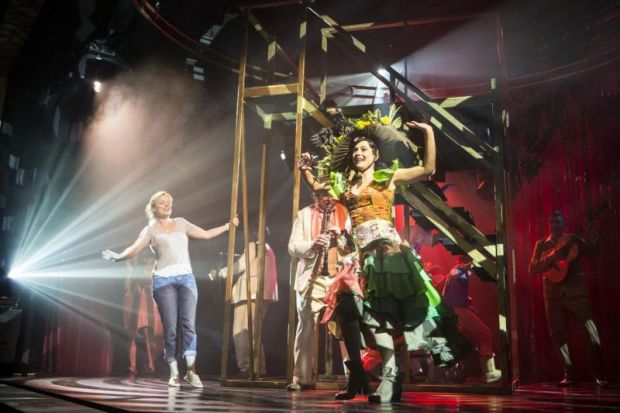
Subscribe to our E-Newsletter, buy our latest print edition or find a Performing Arts book at Book Nook.

